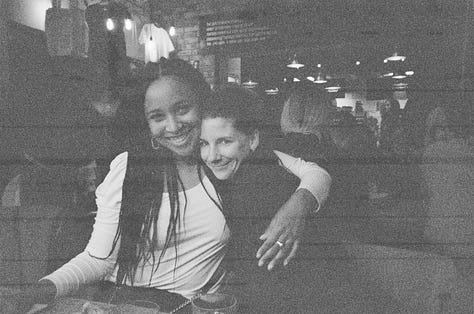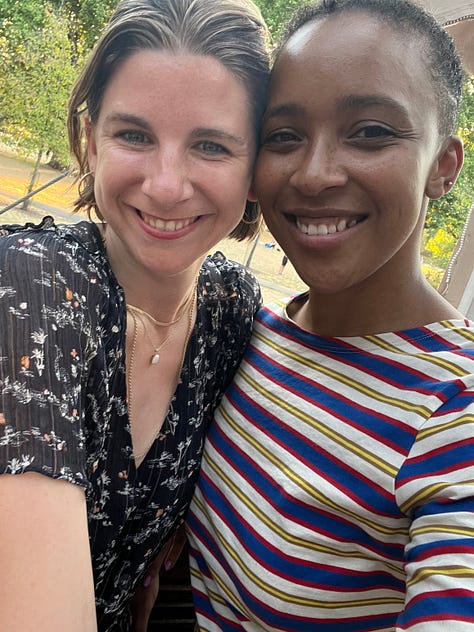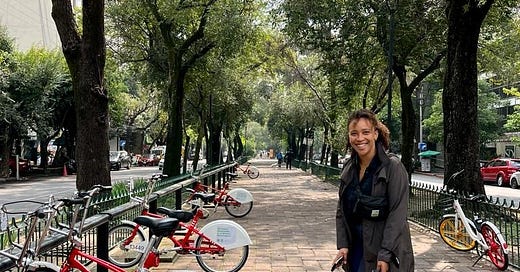Hi friends, Happy Friday!
I’m Bridget. I’m a good friend and former classmate of our Sarah Barnes, and when she noted in the last newsletter that she would be taking a bit of time off, I asked her if I could take on a leg of this marathon of a newsletter.



For the avid follower of this newsletter, you might remember me from my shout-out in newsletters #98 and #149. I’m an urbanist, strategist, project manager, and advisor, dedicating my career thus far to understanding the intersecting systems and policies that keep cities moving 24 hours a day, 7 days a week. Few things make me happier than dissecting those systems and collaboratively building new, better ones to address our most wicked urban challenges. In particular, over the past five years, I have worked for Mayors and their teams on a wide range of challenges but with a keen focus on supporting society’s most marginalized or vulnerable populations—women, young people, unhoused, migrants, disabled persons, or others.
On Radical Inclusion
Last week, an old friend, David Sengeh, published a book called Radical Inclusion: Seven steps to help you create a more just workplace, home, and world. I met David when he was a student building bionic arms and legs at MIT’s Media Lab. Now, he’s the Minister of Education for his home nation of Sierra Leone. This is not a promotion for his book (trust me, he has friends much better placed to do that), but this part memoir, part case study resonated with me and helped sort some of the work and thoughts ruminating in my mind of late.
The book is an in-depth look at David’s process to repeal a long-standing policy prohibiting pregnant young women or girls from attending public school. The radical inclusion David speaks of in his book is not just the radical act of systemic bias but the act of engaging, listening, and holding space and empathy for the conversations that changed hearts and minds that made the repeal and the development of services to support young women possible. David’s story reminds us that human capital is our greatest asset and the single greatest driver of change. As his case study unfolds, he emphasizes that the greatest lever for that change is the willingness to listen with openness and empathy.
Learning from Chicago
This brings me to a recent episode of one of my favorite podcasts, Freakonomics. This episode, A Radically Simple Way to Boost a Neighborhood, follows the story of Discover’s (the credit card company) choice to build a call center in Chicago’s south side to their journey to becoming a responsible and inclusive employer, and its impact on the underinvested and underserved community.
The idea to leverage Discover's investment in a new call center to be a positive force for social change came to CEO, Roger Hochschild, following a lecture by author Ibram X. Kendi. Hochschild could quickly see the mutual benefits of such a choice, but it took some of his colleagues a bit of time to get on board. Eventually, the team acquired an old Target in the Chatham neighborhood of Chicago and invested $40M to renovate the warehouse. Still, Hochschild was told that his investment would not be welcomed without what he referred to as a ‘credible messenger’. Enter Juatise Gathings, a southside native, who, to Discover’s great fortune, had already been working her way up the ranks of the company for years. As Regional Operations Director of the Center, Gathings brought an understanding of the community to the role; still and equally as important, Gathings brought a willingness to reach out, engage and listen to local aldermen, school principals, employees and the community to learn and to serve the community better.
Discover has reported that the Chatham call canter matches levels of productivity to other call centers but dramatically surpasses the others when it comes to staff attrition. The CEO’s simple choice to be more inclusive challenged Discover’s status quo, boosted its bottom line, and now building a community and transforming the lives of many employees and their families in the southside of Chicago.
In the episode, one economist notes the $2.5M in property tax relief given by the City of Chicago to ‘incentivise’ Discover’s move to the area. I won’t choose to battle any economists as to whether or not this investment had the greatest value return. I do, however, want to articulate that the choice is in line with the City’s Community Wealth Building Plan, a plan that’s first recommendation is to center community voices in program design and implementation
Influencing International Cities
I note this piece of work and the strategic thinking of policymakers in City government, and in particular the Office of Equity and Racial Justice, for its direct influence on work we found to spur institutional leadership and strategic alignment in London’s social and economic recovery post pandemic. The London Anchor Institutions' Network (LAIN) brings together institutions from across the municipality that are choosing inclusivity over the status quo.
As we discuss choosing inclusivity in our cities, I must raise the ghastly murder of Jordan Neely on the New York City subway a week ago. For much of the last week, I’ve been perplexed and heartbroken over the details of this event and captivated by Neely's MJ performances and other incredible street performers on youtube. Human capital is our greatest asset. These too often overlooked or underappreciated artists help bring our cities to life and put smiles on people’s faces.
This article in the Boston Globe, I felt got to the point, “feeling threatened is not the same as being threatened… This isn’t just a New York story. It is evidence of a national catastrophe that can neither be ignored nor solved with an unyielding fist.”
We should all be paying attention.
For the past 4 years, I have had the privilege of working in strategy and project management for initiatives to address homelessness, rough sleeping, and in support of the institutions and workers within the sector. I will testify all day, every day, to the thousands of experienced, talented, dedicated people who serve the unhoused and seek out those who need help. City ecosystems are complex, and homelessness is a compounded byproduct of the faults in those systems. The voices of the unhoused and those who serve them best are absolutely essential to the discussion of strategy, practice, or policy.
As they say at the end of each Freakonomics episode - take care of yourself and someone else too if you can. And if you can, please don’t hesitate to donate to or volunteer with BRC, the organization led by the incredible Muzzy Rosenblatt, that serves the unhoused on the NYC Metro, or just be sure to keep a few bucks on hand for the next street performer who puts a smile on your face.
Here’s a few extra articles to hold you over until Sarah’s back next week:
Please - Public Transit Needs Better And Cheaper Payment Systems!
When I worked in Los Angeles as an urban designer, my boss used to show off by telling clients I didn’t have a car. LA has a long way to go, but teaching young people that a car isn't always necessary is a good place to start LA Metro’s GoPass pilot programme extended until June 2024
Once again, the global south leading the way C40 expands support for climate initiatives in Latin America
Customer service in public services matters!
And just a last shout-out to Chicago and a goodbye to Mayor Lori Lightfoot’s administration, I want to highlight some of the really amazing work that has come out of her office during this last stretch of her term, particularly to two teams I’ve had the pleasure of working with—Candace Moore’s Office of Equity and Racial Justice and the team of Chief Technology Officer, Nick Lucius.
Equity based investment in the Chicago Recovery Plan
In advising local governments on equity and/or building trust within communities, I cannot stress the importance of transparency more. Chicago’s Office of Equity and Racial Justice focused on this point from day one
That’s all from Bridget!! Have a beautiful weekend friends.
B




